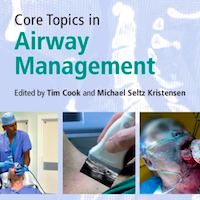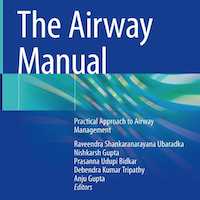Tag: intubation
Core Topics in Airway Management
Management of the airway is an important and challenging aspect of many clinicians' work and is a source of complications and litigation. The new edition of this popular book remains a clear, practical and highly-illustrated... read more

A Retrospective Closed Cohort Study on Distribution of Multidrug-Resistant Bacteria in VAP and its Impact on Patient Outcome
Gram-negative organisms, particularly Klebsiella and Acinetobacter, were the main multidrug-resistant (MDR) ventilator-associated pneumonia (VAP) culprits. MDR-VAP exhibited higher morbidity and mortality. A study... read more
Oxygen Therapy and Noninvasive Respiratory Supports in Acute Hypoxemic Respiratory Failure
Whereas oxygen supplementation should be initiated for patients with acute hypoxemic respiratory failure defined as PaO2 below 60 mm Hg or SpO2 ... read more
Sleep Disturbances Impact on Outcomes in ICU
Complete disappearance of rapid eye movement (REM) sleep was frequently observed in ICUs (50% of patients) and may occur at all times during the ICU stay, as well as in patients breathing spontaneously, after admission or... read more
Optimizing Oxygenation For Tracheal Intubation in Critically Ill Patients
Tracheal intubation (TI) is a common procedure frequently performed in critically ill patients and is an integral part of emergency airway management (EAM). However, it carries inherent risks and can significantly impact... read more
Tracheal Intubation in Critically Ill Adults with a Physiologically Difficult Airway
Using a Delphi method, agreement among a panel of international experts was reached for 53 statements providing guidance to clinicians worldwide on safe tracheal intubation practices in patients with a physiologically difficult... read more
Pressure Support Ventilation During ECMO Support in Patients with ARDS
In the initial phases of veno-venous extracorporeal membrane oxygenation (VV ECMO) support for severe acute respiratory distress syndrome (ARDS), ultraprotective controlled mechanical ventilation (CMV) is typically employed... read more
Prehospital Treatment of Severely Burned Patients
In the Berlin metropolitan area, paramedics and emergency physicians caring for severely burned patients need to consider long transport times. Current adherence to prehospital treatment recommendations is unsatisfactory.... read more
The Airway Manual: Practical Approach to Airway Management
The book provides up-to-date and easy to understand information on airway management with special emphasis on practical management along with required theory background and key points. It covers all aspects of airway management... read more

Cardiac Arrest During a Ferric Derisomaltose Infusion Followed by Complete Heart Block
Bradycardia and heart block are rarely reported in the parenteral iron literature. Although rare, it may be reasonable to consider parenteral iron as a toxicological etiology for patients presenting with complete heart block... read more
Impact of extended lung protection during mechanical ventilation on lung recovery in patients with COVID-19 ARDS
The extended lung protection with strict control of ΔP for moderate to severe ARDS plus deranged mechanics is feasible and could be implemented in this pilot study with some beneficial impact on the recovery of lung function.... read more
Cardiac Arrest Following Prone Positioning
The complications that can arise from the prone position are often underestimated. Proceduralists, surgeons, and anesthesiologists need to be thoroughly knowledgeable about the common physiological changes that can occur... read more
Noninvasive Ventilation for Preoxygenation during Emergency Intubation
Among critically ill adults undergoing tracheal intubation, preoxygenation with noninvasive ventilation resulted in a lower incidence of hypoxemia during intubation than preoxygenation with an oxygen mask. Among the 1,301... read more
Risk Factors of Post-intubation Hypotension in Severe Pneumonia Patients
Post-intubation hypotension (PIH) was one of the serious complications after Endotracheal intubation (ETI) in Severe pneumonia (SP) patients. The risk factors of PIH were investigated in SP patients to provide a theoretical... read more
Improving Spontaneous Breathing Trials With a Respiratory Therapist-Driven Protocol
This quality improvement (QI) project aimed to standardize and re-establish RT-driven protocol for screening patients for SBT readiness and administering SBTs to appropriate patients. Endotracheally intubated and mechanically... read more
Critical Hypertension in Trauma Patients Following Prehospital Emergency Anesthesia
Delivery of prehospital emergency anesthesia (PHEA) to seriously injured trauma patients risks hemodynamic fluctuation. In adult trauma patients undergoing PHEA, 11.9% of patients experienced post-PHEA critical hypertension.... read more
Effect of Mechanical Ventilation Under Intubation on Respiratory Tract Change of Bacterial Count
Mechanical ventilation under intubation may cause dysregulation of lower respiratory microbiota in rats. The most common 'second strike' in mechanically ventilated patients is a pulmonary infection caused by the ease with... read more
Convalescent Plasma Cuts Death by 10% in COVID Patients on Mechanical Ventilation
A randomized clinical trial in Belgium finds that convalescent plasma reduces death rates by about 10% in COVID-19 patients requiring invasive mechanical ventilation. University of Liege researchers led the open-label... read more
HFNC vs. CPAP in COVID-19 Patients with ARDS in ICU
Acute hypoxic respiratory failure in coronavirus disease 2019 (COVID-19) pneumonia has been treated with oxygen delivered by oxygen masks and non-invasive ventilation (NIV) with continuous positive airway pressure (CPAP),... read more
Tracheal Intubation of Critically Ill Adults: Video vs. Direct Laryngoscopy
Successful intubation on the first attempt occurred in 600 out of 705 patients (85.1%) in the video-laryngoscope group and 504 out of 712 (70.8%) in the direct-laryngoscope group (ARR, 14.3%; 95% CI, 9.9 to 18.7; p... read more
Transnasal Humidified Rapid-Insufflation Ventilatory Exchange vs. Conventional Facemask Breathing for Preoxygenation During Rapid Sequence Induction
Transnasal humidified rapid-insufflation ventilatory exchange (THRIVE), if used for pre-oxygenation and apnoeic oxygenation, has the propensity to extend the safe apnoea time and thereby decrease the incidence of desaturation... read more
Nasotracheal vs. Orotracheal Intubation for Sedation in Critically Ill Patients
Nasotracheal intubation (NTI) may be used for long term ventilation in critically ill patients. Although tracheostomy is often favored, NTI may exhibit potential benefits. Compared to orotracheal intubation (OTI), patients... read more









